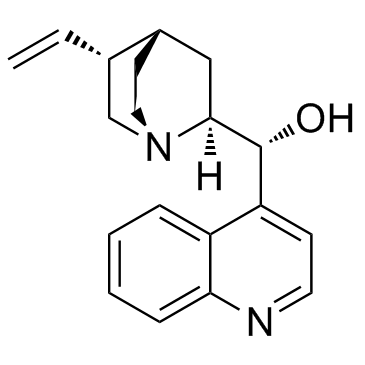辛可尼定

辛可尼定结构式

|
常用名 | 辛可尼定 | 英文名 | Cinchonidine |
|---|---|---|---|---|
| CAS号 | 485-71-2 | 分子量 | 294.391 | |
| 密度 | 1.2±0.1 g/cm3 | 沸点 | 464.5±30.0 °C at 760 mmHg | |
| 分子式 | C19H22N2O | 熔点 | 204-206ºC | |
| MSDS | 中文版 美版 | 闪点 | 234.7±24.6 °C | |
| 符号 |


GHS07, GHS08 |
信号词 | Warning |
|
Thousands of chemical starting points for antimalarial lead identification.
Nature 465 , 305-10, (2010) Malaria is a devastating infection caused by protozoa of the genus Plasmodium. Drug resistance is widespread, no new chemical class of antimalarials has been introduced into clinical practice since 1996 and there is a recent rise of parasite strains with redu... |
|
|
Direct, catalytic, and regioselective synthesis of 2-alkyl-, aryl-, and alkenyl-substituted N-heterocycles from N-oxides.
Org. Lett. 16(3) , 864-7, (2014) A one-step transformation of heterocyclic N-oxides to 2-alkyl-, aryl-, and alkenyl-substituted N-heterocycles is described. The success of this broad-scope methodology hinges on the combination of copper catalysis and activation by lithium fluoride or magnesi... |
|
|
Membranes for specific adsorption: immobilizing molecularly imprinted polymer microspheres using electrospun nanofibers.
Chimia 65(3) , 182-6, (2011) Molecularly imprinted polymer microspheres were immobilized within a polymer nanofiber membrane by electrospinning. Such membranes simplify the handling of functional microspheres and provide specific recognition capabilities for solid-phase extraction and fi... |
|
|
Synthesis and optical resolution of an allenoic acid by diastereomeric salt formation induced by chiral alkaloids.
Chirality 20(1) , 47-50, (2008) A synthetic procedure for the preparation of 4-cyclohexyl-2-methyl-buta-2,3-dienoic acid in the two optically active forms has been developed. Synthesis of the racemic allenoic acid was made by an efficient route with good overall yield. Resolution of the ena... |
|
|
An improved synthesis of 10,11-didehydro Cinchona alkaloids.
Chirality 20(3-4) , 441-5, (2008) A revised procedure for the conversion of the four major Cinchona alkaloids (quinine, quinidine, cinchonidine, and cinchonine) into their respective 10,11-didehydro derivatives is described. The reported protocol offers several advantages over a recently publ... |
|
|
Tosyl esters of cinchonidine and cinchonine alkaloids: the structure-reactivity relationship in the hydrolysis to 9-epibases.
Acta Crystallogr. C 67(Pt 9) , o346-9, (2011) In the crystal structures of the diastereoisomers of O-tosylcinchonidine [(9R)-cinchon-9-yl 4-methylbenzenesulfonate], (I), and O-tosylcinchonine [(9S)-cinchon-9-yl 4-methylbenzenesulfonate], (II), both C(26)H(28)N(2)O(3)S, both molecules are in an anti-close... |
|
|
Stereoselective inhibition of serotonin transporters by antimalarial compounds.
Neurochem. Int. 73 , 98-106, (2014) The serotonin (5-HT) transporter (SERT) is an integral membrane protein that functions to reuptake 5-HT released into the synapse following neurotransmission. This role serves an important regulatory mechanism in neuronal homeostasis. Previous studies have de... |
|
|
Homochiral crystallization of microporous framework materials from achiral precursors by chiral catalysis.
J. Am. Chem. Soc. 130(39) , 12882-3, (2008) While it is not uncommon to form chiral crystals during crystallization, the formation of bulk porous homochiral materials from achiral building units is rare. Reported here is the homochiral crystallization of microporous materials through the chirality indu... |
|
|
Monodispersed, molecularly imprinted polymers for cinchonidine by precipitation polymerization.
Talanta 80(5) , 1713-8, (2010) Three monodispersed, molecularly imprinted polymers (MIPs) for cinchonidine (CD) have been synthesized by precipitation polymerization. MIP1 was prepared using methacrylic acid (MAA) as a functional monomer and divinylbenzene (DVB) as a cross-linker and MIP2 ... |
|
|
Templating effect in DNA proximity ligation enables use of non-bioorthogonal chemistry in biological fluids.
Artif. DNA PNA XNA 3(3) , 123-8, (2012) Here we describe the first example of selective reductive amination in biological fluids using split aptamer proximity ligation (StAPL). Utilizing the cocaine split aptamer, we demonstrate small-molecule-dependent ligation that is dose-dependent over a wide r... |